











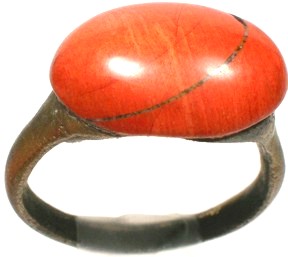
Very Elegant Genuine Ancient Roman Bronze Ring Ring Size 9; Circa 300 A.D.
CLASSIFICATION: Ancient Roman Bronze Ring. Antique Handcrafted Eighteenth Century Nubian Red Jasper Semi-Precious Gemstone.
ATTRIBUTION: Eastern Roman Empire (Provincial Pamphylia – present-day Southern Turkey), Third or Fourth Century A.D.
SIZE/MEASUREMENTS: Fits ring size 9 (U.S.).
Diameter: 22 1/2mm * 21mm (outer dimensions excluding gemstone); 20mm * 19 1/4mm (inner diameter).
Bezel: 15mm (breadth) * 11mm (height), excluding gemstone.
Gemstone: 18mm (breadth) * 13mm (height) * 5 1/2mm (thickness). 9.28 carats (approximate weight).
Tapered Width Band: 9mm (at bezel) * 3mm (at sides) * 2 1/2mm (at back).
Weight: 3.88 grams (without gemstone).
CONDITION: Excellent! Completely intact, moderate wear consistent with sustained (ancient) usage, minimal porosity (surface pitting caused by contact with earth while buried). Professionally conserved.

DETAIL: A nicely styled Roman bronze ring of a simple “solitaire” design, ordinary bands with a boldly-sized bezel seemingly intended to hold a gemstone. The ring was not actually recovered with the gemstone intact, however usually this style of bronze ring was set either with a glass gemstone (glass was quite costly) or with some form of quartz crystal; i.e. clear quartz, orange quartz (“carnelian”), or purple quartz (“amethyst”). The ring is of heavy and durable one-piece construction, much like a contemporary ring. The more archaic rings produced by Roman artisans were characteristically made in two pieces; an incomplete ring (a “shank”) with a separately crafted bezel which was brazed to the shank in order to assemble the ring.
The ring seems almost certainly to have been originally crafted with the intent to hold a gemstone. The bezel was flat and undecorated except that the surface was intentionally roughened or textured, as if to better hold an adhesive between the bezel and the gemstone. The Romans had a number of different adhesives they used, some of the most common being resin and bitumen. However one characteristic that they all had in common is that sooner or later, they tended to fail. Consequentially ancient “gemstone” rings are typically unearthed without the gemstone. True to form, this particular ring was not recovered with the gemstone intact, so we mounted a large, natural, antique, handcrafted eighteenth century red jasper semi-precious gemstone so as to preserve a sense of historical continuity. Jasper is a red to red-orange-colored gemstone of the agate family which was enormously popular with the Romans, Greeks, Egyptians, Phoenicians, Sumerians, etc.
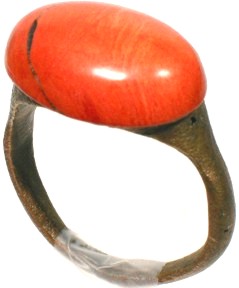
This particular specimen is a very nice quality eighteenth century antique hand crafted/shaped/polished red jasper semi-precious gemstone from the Nubian region of Southern Egypt/Sudan. The fabled land of ancient Nubia was the source of the red jasper held so precious by the Pharaohs of ancient Egypt. Carved into jewelry and religious amulets, red jasper was obtained from the Nubian Upper Nile, typically in the form of annual tributes to the Pharaoh. As well ancient Egypt received annual tribute of their treasured red jasper from “the land of Punt”. But there exact whereabouts of Punt (and the pygmy black tribesmen of legend) remains a mystery today. A religiously significant amulet known as an “Isis Tit” was carved from red jasper and placed at the throat of the mummified remains of Egyptian Pharaohs and Royalty.
This eighteenth century red jasper gemstone originated from the same Nubian region which presently is part of both Southern Egypt and Northern Sudan. Crafted by an eighteenth century Russian artisans into this beautiful polished cabochons, part of an heritage renown for the production of the elaborate gemstones and jewelry of the Czars of Medieval, Renaissance, and Victorian Russia. Jasper, as well as other forms of agate, were extremely popular throughout the ancient Mediterranean, and maintained its immense popularity through Renaissance and into Victorian Europe. The gemstone is not particularly valuable, given the fact that the Romans made wide use of agate in their jewelry, it seemed an appropriate gemstone to enhance this ring’s beauty.
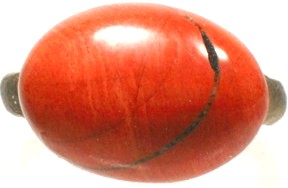
Fate has been kind, and the ring has been preserved in wonderful condition. Of course the ring does evidence some moderate “all-over” wear. However this should not be a source for disappointment. You must keep in mind that the ring was produced by an artisan and sold to a patron or consumer with the idea that the ring would be enjoyed and worn by the purchaser. And without any regard to twenty-first century posterity, that precisely what happened! The original Roman owner of this ring wore it, enjoyed it, and probably never could have in his most delusional moment ever dreamed that almost two thousand years into the future their ring would still exist.
It should likewise come as no surprise that upon close inspection are detected the telltale signs that the ring spent thousands of years in the soil. Porosity is fine surface pitting (oxidation, corrosion) caused by extended burial in caustic soil. Many small ancient metal artifacts such as this are extensively disfigured and suffer substantial degradation as a consequence of the ordeal of being buried for millennia. It is not at all unusual to find metal artifacts decomposed to the point where they are not much more substantial than discolored patterns in the soil. Actually most smaller ancient artifacts such as this are so badly oxidized that oftentimes all that is left is a green (bronze) or red (iron) stain in the soil, or an artifact which crumbles in your hand. However this specimen is not so heavily afflicted, and certainly has not been disfigured.
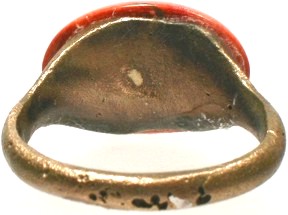
To the cursory inspection of the casual admirer, it simply looks like an ancient ring, nicely surfaced, no immediately discernible blemishes. You have to search for the telltale signs indicating the ring was buried for millennia. No denying, there is oxidation, you can clearly see the evidence in these photo enlargements, or if in hand you inspect the ring intently. However the extent is relatively mild, except at the very back of the band where you can clearly see a number of small pits where this portion of the ring evidently rested in some sort of caustic soil constituent, the result a few spots of corrosion. Notwithstanding these blemishes, the ring spent almost 2,000 years buried, yet by good fortune there is only a modest degree of porosity evidenced. It happened to come to rest in relatively gentle soil conditions. Consequentially, the integrity of the artifact remains undiminished, and despite the wear, the rings remains quite handsome, and entirely wearable.
The ring is almost modern and quite distinctive in appearance, a classic and timeless design. The ring has a very nice medium bronze, almost “golden” tone, unmistakably bronze, but very attractive. The Romans were of course very fond of jewelry, oftentimes wearing a ring on each finger – and sometimes even on both the second and third joint of each finger. They also had a fondness for many other forms of personal jewelry including bracelets worn both on the forearm and upper arm, belt buckles, chains, pendants, earrings, hair pins, and brooches. This particular piece of ancient jewelry is an interesting historical RELIC which pertains not only to the history of Rome, but also to the history of jewelry production. It could easily be worn and enjoyed on a daily basis, an evocative authentic “souvenir” of the glory and grandeur which was the Roman Empire, the greatest military power, and one of the most advanced civilizations of the ancient world. Almost two thousand years after it was originally produced, it could still bring its next owner many decades of wearing enjoyment.

ROMAN HISTORY: One of the greatest civilizations of recorded history was the ancient Roman Empire. In exchange for a very modest amount of contemporary currency, you can possess a small part of that great civilization in the form of a 2,000 year old ancient Roman artifact. The Roman civilization, in relative terms the greatest military power in the history of the world, was founded in the 8th century (B.C.). In the 4th Century (B.C.) the Romans were the dominant power on the Italian Peninsula, having defeated the Etruscans and Celts. In the 3rd Century (B.C.) the Romans conquered Sicily, and in the following century defeated Carthage, and controlled the Greece. Throughout the remainder of the 2nd Century (B.C.) the Roman Empire continued its gradual conquest of the Hellenistic (Greek Colonial) World by conquering Syria and Macedonia; and finally came to control Egypt in the 1st Century (B.C.).
The pinnacle of Roman power was achieved in the 1st Century (A.D.) as Rome conquered much of Britain and Western Europe. At its peak, the Roman Empire stretched from Britain in the West, throughout most of Western, Central, and Eastern Europe, and into Asia Minor. For a brief time, the era of “Pax Romana”, a time of peace and consolidation reigned. Civilian emperors were the rule, and the culture flourished with a great deal of liberty enjoyed by the average Roman Citizen. However within 200 years the Roman Empire was in a state of steady decay, attacked by Germans, Goths, and Persians. In the 4th Century (A.D.) the Roman Empire was split between East and West. The Great Emperor Constantine temporarily arrested the decay of the Empire, but within a hundred years after his death the Persians captured Mesopotamia, Vandals infiltrated Gaul and Spain, and the Goths even sacked Rome itself. Most historians date the end of the Western Roman Empire to 476 (A.D.) when Emperor Romulus Augustus was deposed. However the Eastern Roman Empire (The Byzantine Empire) survived until the fall of Constantinople in 1453 A.D.
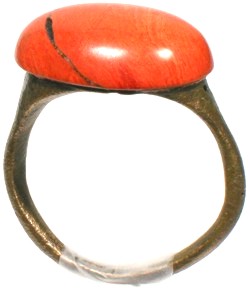
In the ancient world valuables such as coins and jewelry were commonly buried for safekeeping, and inevitably the owners would succumb to one of the many perils of the ancient world. Oftentimes the survivors of these individuals did not know where the valuables had been buried, and today, thousands of years later caches of coins and rings are still commonly uncovered throughout Europe and Asia Minor. Throughout history these treasures have been inadvertently discovered by farmers in their fields, uncovered by erosion, and the target of unsystematic searches by treasure seekers. With the introduction of metal detectors and other modern technologies to Eastern Europe in the past three or four decades, an amazing number of new finds are seeing the light of day thousands of years after they were originally hidden by their past owners. And with the liberalization of post-Soviet Eastern Europe, new markets have opened eager to share in these ancient treasures.
HISTORY OF BRONZE: Bronze is the name given to a wide range of alloys of copper, typically mixed in ancient times with zinc, tin, lead, or arsenic. The discovery of bronze enabled people to create metal objects which were better than previously possible. Tools, weapons, armor, and building materials made of bronze were harder and more durable than their stone and copper predecessors from the “Chalcolithic” (the “Copper Age”), i.e., about 7000-3500 B.C., and the Neolithic (“New Stone Age”), i.e. about 12000 to 7000 B.C.). Of particular significance were bronze agricultural implements, tools for cutting stone, and weapons. Culturally significant was bronze statuary, particularly that of the Romans and Greeks. The ancient Greeks and Romans had a long history of making statuary in bronze. Literally thousands of images of gods and heroes, victorious athletes, statesmen, and philosophers filled temples and sanctuaries, and stood in the public areas of major cities. In fact, the Statue of Zeus at OLYMPIA and the Colossus of Rhodes are two of the Seven Wonders of the Ancient World.

Initially bronze was made out of copper and arsenic. It was only later that tin was used, becoming (except in ancient Egypt) the sole type of bronze in the late 3rd Millennium B.C. Tin-alloyed bronze was superior to arsenic-alloyed bronze in that the alloying process itself could more easily be controlled, the alloy was stronger and easier to cast, and unlike arsenic, tin is not toxic. Toxicity was a major factor in the production of arsenic bronze. Repeated exposure to arsenic fumes ultimately led to nerve damage in the limbs. Evidence of the long agony of Bronze Age metalsmiths came down to the ancient Greeks and Romans in the form of legend, as the Greek and Roman gods of metalsmiths, Greek Hephaestus and Roman Vulcan, were both lame. In practice historical bronze alloys are highly variable in composition, as most metalworkers probably used whatever scrap was to hand. In one instance of ancient bronze from Britain, analysis showed the bronze to contain a mixture of copper, zinc, tin, lead, nickel, iron, antimony, arsenic, and silver.
Other advantages of bronze over iron include that bronze better resists corrosion, particularly seawater corrosion; bronze resists metal fatigue better than iron; and bronze is a better heat conductor (and thus is better suited for cooking vessels). However ancient bronze, unless conserved properly, is susceptible to “bronze disease”, wherein hydrochloric or hydrosulfuric acid is formed due to impurities (cuprous chloride or sulfur) found within the ancient bronze. Traditionally archaeology has maintained that the earliest bronze was produced by the Maikop, a proto-Indo-European, proto-Celtic culture of Caucasus prehistory around 3500 B.C. Recent evidence however suggests that the smelting of bronze might be as much as several thousand years older (bronze artifacts dating from about 4500 B.C. have been unearthed in Thailand).
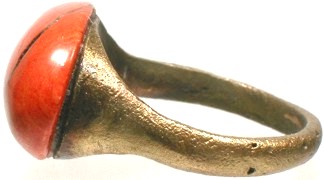
Shortly after the emergence of bronze technology in the Caucasus region, bronze technology emerged in ancient Mesopotamia (Sumer), Egypt, the Indus Valley Civilization of Northern India, the Aegean, the Caspian Steppes (Ukraine), the Southern Russia/Central Mongolia Region (the Altai Mountains), the Levant (Eastern Mediterranean), Anatolia (Turkey) and the Iranian Plateau. By the late third Millennium B.C. many Western European Bronze Age Cultures had emerged. Some of the more notable were the Celtic cultures of Middle Europe stretching from Hungary to Poland and Germany, including the Urnfield, Lusatian, and (Iron Age Transitional) Hallstatt Cultures. The Shang in ancient China also developed a significant Bronze Age culture, noted for large bronze burial urns. The ancient Chinese were the first to cast bronze (using the “lost wax” technique) about 2200 B.C. Prior to that time all bronze items were forged. Though weapons and utilitarian items were produced in great numbers, the production of bronze in ancient China was especially noteworthy for ornamented ritualistic/religious vessels (urns, wine vessels, water pots, food containers, and musical instruments), many of immense size.

Britain’s Bronze Age cultures included the Beaker, Wessex, Deverl, and Rimbury. Copper and tin ores are rarely found together, so the production of bronze has always involved trade. Cornwall was one of the most significant sources of tin not only for Britain, but exported throughout the Mediterranean. Other significant suppliers of tine were the Taurus Mountains of Anatolia (Turkey), as well as Spain. Enormous amounts of copper was produced from the Great Orme mine in North Wales, the island of Cyprus, the European Alps, and from the Sinai Peninsula and other nearby sites in the Levant. Though much of the raw minerals may have come from Britain, Spain, Anatolia, and the Sinai, it was the Aegean world which controlled the trade in bronze. The great seafaring Minoan Empire (about 2700 to 1450 B.C.) appears to have controlled, coordinated, and defended the trade.
Tin and charcoal were imported into Cyprus, where locally mined copper was mined and alloyed with the tin from Britain. Indicative of the seafaring trade in the Eastern Mediterranean, a shipwreck from about 1300 B.C. off the Turkish coast revealed a ship carrying a ton of copper ingots, several dozen small tin ingots, new bronze tools, scrap metal, and a blacksmith's forge and tools (along with luxury trade goods from Africa). It appears that the Bronze Age collapsed with the fall of Minoan Empire, to be replaced by a Dark Age and the eventual rise of the Iron Age Myceneans (on mainland Greece). Evidence suggests that the precipitating event might have been the eruption of Thera (Santorini) and the ensuing tsunami, which was only about 40 miles north of Crete, the capital of the Minoan empire.
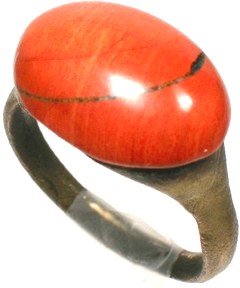
Some archaeologists argue that it was Santorini itself which was the capitol city of the Minoan World. However where Crete or Santorini, it is known that the bread-basket of the Minoan trading empire, the area north of the Black Sea lost population, and thereafter many Minoan colony/client-states lost large populations to extreme famines or pestilence. The end of the Bronze Age and the rise of the Iron Age is normally associated with the disturbances created by large population disruptions in the 12th century B.C. The end of the Bronze Age saw the emergence of new technologies and civilizations which included the large-scale production of iron (and limited scale production of steel).
Although iron was in many respects much inferior to bronze (and steel was inefficiently produced in very limited quantities), iron had the advantage that it could be produced using local resources during the dark ages that followed the Minoan collapse, and was very inexpensive when compared to the cost of producing bronze. Bronze was still a superior metal, resisting both corrosion and metal fatigue better than iron. And bronze was still used during the Iron Age, but for many purposes the weaker iron was sufficiently strong to serve in its place. As an example, Roman officers were equipped with bronze swords while foot soldiers had to make do with iron blades.

Pliny the Elder, the famous first century Roman historian and naturalist, wrote about the reuse of scrap bronze and copper in Roman foundries, noting that the metals were recast as armor, weapons or articles for personal use, such as bronze mirrors. The melting and recasting foundries were located at the Italian port city of Brindisi. Located on the Adriatic coast, Brindisi was the terminus of the great Appian Way, the Roman road constructed to facilitate trade and military access throughout the Italian part of the Roman Empire. The city was the gateway for Roman penetration into the eastern parts of her empire (Greece, the Eastern Mediterranean, the Black Sea Region, the Danubian Provinces, and eventually Mesopotamia).
HISTORY OF JASPER: Jasper is a form of agate, and belongs to the chalcedony family of gemstones, which in turn is part of the quartz family of gemstones. Jasper is very similar to citrine and amethyst in make up, but possessing such large amounts of trace elements such as iron and sulfur (which provide the colors) that they are opaque rather than transparent. The biggest difference between a red jasper and a citrine is that there is probably 20% to 30% more iron in the sasper. The crystals in jasper gemstones are so dense and so tightly compacted that they are invisible to the naked eye. It often contains organic material and mineral oxides which give it interesting patterns, bands and colors. Many of these patterns resemble landscapes with mountains and valleys. Jasper occurs in red, green, blue, brown, pink, purple, yellow, white, gray and black.

Jasper was a favorite gem in ancient times and is referenced in Greek, Roman, Hebrew, Persian, East Indian Indus Valley (Harappan), Assyrian and Latin literature. In the Bible jasper was described as one of the twelve stones in the breastplate of Aaron, representing the twelve tribes of Israel. Referenced again in the New Testament, jasper is listed as one of the foundation stones of post-apocalyptic New Jerusalem. The name Jasper comes to us from the Greek language. “Jaspis”, or the ancient spelling “Iaspis” meaning “spotted stone”. It was also the name of a mythical stone found in the head of the adder snake. Greek warriors carried a jasper talisman to give them courage in battle. This association with bravery and warriors carried all the way into the Middle Ages, where one name for jasper was "the stone of warriors."
Early Mediterranean shamans or wizards believed that jasper was a very sacred stone. Blue colored Jaspers were used to travel safely back and forth to the Spirit World. Red Jasper represented the blood of the Great Mother and was used to connect with the Earth in healing ceremonies. Green Jaspers were used to call the rain. Magicians in fourth century Britain placed carved Jasper bowls at the corners of a farmer's field to bring rain for the crops (many American Indian tribes shared the belief that jasper had the ability to bring rain).

According to the Medieval Norse tenth century Volsunga Saga (click for more on this legend), the sword hilt of Sigurd (also known as Siegfried), a legendary hero of Viking mythology and son of Sigmund the king, was set with jasper. Medieval authors of the 11th and 12th centuries wrote volumes about the protective powers of the Jasper. It was written that the gemstone drove away evil spirits and protected the wearer from the bites of poisonous snakes and spiders. It was also recommended that women hold a piece of jasper in the hand during childbirth to guard against the evil that could come to the mother and child by demons of the air. Physicians in the Middle Ages wore jasper amulets to aid them in their diagnoses, and stocks of jasper were kept in every pharmacy. Jasper was thought to drive away evil spirits and cure fevers, dropsy, and epilepsy. It was also believed to quicken thought and action, and at the same time ensure caution and the avoidance of needless risk.
However mankind’s relationship with Jasper, especially red jasper, is much more ancient than merely Medieval Europe, or even the Classical Greeks. It dates back as early as Stone-Age France (20,000 B.C.) where it was found to be used for ornamental objects; and to the ancient Babylonians (1,000 B.C.) where it was used in seals which have been found in ancient ruins. In between the Neolithic Stone Age and the Babylonians, green jasper was used to make bow drills in the Harappan Indus Valley civilization 7,000 years ago (circa 5,000 B.C.), and jewelry shortly thereafter. On Minoan Crete jasper was carved to produce seals almost 4,000 years ago (circa 1800 B.C.), as evidenced by archaeological recoveries at the palace of Knossos. In ancient China, green jasper was often used by the Chinese in place of (much more costly) jade in the mouth of the dead.

The ancient Egyptians used red jaspers to represent the blood of their goddess Isis. Amulets of the gem were said to have the same attributes as the goddess' blood itself, and when worn as an amulet helped prepare one for the judgment of Osiris upon death. Thus Chapter 156 of the Book of the Dead required the amulet in the form of the Girdle Tit of Isis, placed at the throat of the mummy, to be made of red jasper, whose blood-like coloring would enhance the words of the spell: ‘You have your blood, Isis; you have your power.’ You can see an outstanding red jasper amulet of this style, courtesy of The British Museum, by clicking right here. Emanating from the same powers of Isis, an amulet carved of red jasper in the form of a serpent’s head was believed to prevent the body from being bitten by snakes in the underworld. The ancient Egyptians also carved sacred scarab amulets from red jasper as a symbol of eternal life.
The ancient Egyptian word for red jasper, khenmet (hnmt), was derived from the verb “hnm”, and meant “to delight”. Red jasper was extremely popular in Ancient Egypt, expensive, and especially favored for use in earrings (click here to see red jasper earrings of ancient Egyptian/Nubian origin). Red jasper came to ancient Egypt from Nubia (a region laying between present-day Southern Egypt and Sudan) and from Punt (somewhere as yet unknown in Africa) in the form of regular tributes to the Pharaoh. In fact an ancient papyrus detailing the tribute from Nubia survives to present time (see here). Red jasper tributes from both Nubia and Punt were discovered in the Thebes tomb of Rekhmire and the tomb of Iamunedjeh; both were high officials of King Tuthmosis III (1450 B.C.).

Jasper was also carved into intaglio seals (as in signet rings), not only by the ancient Egyptians, but by the ancient Greeks and Romans as well, and was also very popular for use as carved cameos. You can see an outstanding red intaglio seal of Marc Antony, courtesy of The British Museum, by clicking right here. The ancient Greeks and Romans believed that if athletes wore the stone they would gain endurance. The ancient Greeks called it heliotrope sun (helios) and turner (tropos) because it was believed to turn the sun red if the sun’s reflection was shown in a bowl of water holding the stone.
Mankind’s belief that Jasper contained magical powers persisted well into the Middle Ages where jasper was a favorite gemstone with shamans, magicians and mystics. Blue jasper was used as a medium to connect with the afterworld; red jasper was believed to enhance health, concentration, self-discipline, energy, focus and to shepherd a soul toward rebirth; yellow jasper protected the user while traveling to the spirit world; and brown jasper also providing protection in the form of “grounding”. One particular jasper known as “bloodstone” is a green stone with drops and splotches of red. The variety was so named by ancient Christians who believed that it represented the blood of the crucifixion dripping from Christ’s wounds onto a dark green stone that lay beneath it. Due to this belief, bloodstone became the favored stone of the Crusaders.

Jasper was used widely during the Renaissance in an art form known as “commesso”, the roots of which can be traced back to the ancient Roman Empire. During the later Roman Empire the art form was known as “opus sectile”, and it involved large pieces of thinly cut stone (marble, mother of pearl, chalcedonies such as jasper, glass, etc.) which were joined together to make a picture or design, much like a picture-puzzle, most often to be inlaid into walls and floors. The materials were cut into thin pieces, polished, and then cut according to the design so that they fit one another without the use of grout. Unlike mosaic techniques, where the placement of very small uniformly-sized pieces forms a design, “opus sectile” pieces were much larger and could be shaped to define large parts of the design.
In the Middle Ages the technique became known as “cosmatesque”, and floors and small columns on tombs and altars continued to use inlays of different colors in geometric patterns. Byzantine art continued with inlaid floors, but also produced some small religious figures in hardstone inlays. In the Italian Renaissance the technique was often referred to as “painting in stone”. The center of the art form was late 16th century in Florence, Italy. “Pictures” were created using thin, cut-to-shape pieces of brightly colored, semiprecious stones. “Commesso” pictures (also known as “pietra dura”), which typically made use of various chalcedonies such as jasper, ranged from emblematic and floral subjects to landscapes, and were used mainly for tabletops and small wall panels, but also for jewelry, cameos, small boxes, etc.

During the Renaissance jasper was also widely used as an architectural in many of Europe's architectural "jewels." One such jewel is the Usimbardi Chapel inside the Church of Santa Trinita, built from 1602-07 in Florence, Italy. Renowned Florentine painter, architect, and poet Ludovico Cardi (1559-1613) decorated the pilaster strips of the chapel with agate, chalcedony, jasper and lapis lazuli inlays or "cladding". Another treasure is in Prague where the Chapel of St. Wenceslas, built in the 1400's completely inside the St. Vitus Cathedral, has walls of large paintings interspersed with stones of carnelian, amethyst, chalcedony, jasper and chrysoprase. St. Vitus Catherdral is considered to be the one of the most important monuments of Czech art, is dedicated to St. Vitus, an Italian martyr put to death by the Emperor Diocletian in 304 or 305 A.D.
Throughout the history of the ancient world, gemstones were believed capable of curing illness, possessed of valuable metaphysical properties, and able to provide protection. Found in Egypt dated 1500 B. C., the "Papyrus Ebers" offered one of most complete therapeutic manuscripts containing prescriptions using gemstones and minerals. Gemstones were not only valued for their medicinal and protective properties, but also for educational and spiritual enhancement. In the ancient world jasper was used as a cure for skin, intestinal, and stomach disorders (including ulcers), as well as gynecological complaints. Green jasper in particular was used to cure kidney, spleen and gall bladder ailments. The green and red jasper known as “bloodstone” was (predictably) believed to stop bleeding or hemorrhaging. Jasper was also used as a sleep aid, and believed to bring happiness into the wearer’s life. In many ancient cultures, jasper was carved into amulets protective or magical devices guarding the wearer against illness, disaster, demons or harm in the afterlife (as described in detail in the preceding paragraphs).

Modern practitioners believe that jasper has magical properties which can enhance the wearers spiritual connection to the earth, or in spells and charms for protection, stability, self-reliance, prosperity, inspiration and good fortune. Jasper is also believed to prevent nightmares and strengthen the mind against depression and negative thoughts. The stone is also used to increase self confidence and independence and ward off mental or psychic domination by others, helping the wearer break free from an oppressive situation or an abusive relationship. Jasper is also believed to soothe nerves, ease the wearer's mental state, and to induce relaxation. Many contemporary healers also recommend jasper as an aid to healing after an illness, and believe that amongst its benefits is the ability to help the body absorb vitamins and minerals while expelling toxins. Jasper is also believed by many healers to cure insanity, bring out evil spirits in persons possessed by demons, aid in overcoming jealousy, and bring about truth and monetary gain.
ADDITIONAL PURCHASES do receive a VERY LARGE Your purchase will ordinarily be shipped within 48 hours of payment. We package as well as anyone in the business, with lots of protective padding and containers.

We do NOT recommend uninsured shipments, and expressly disclaim any responsibility for the loss of an uninsured shipment. Unfortunately the contents of parcels are easily “lost” or misdelivered by postal employees – even in the USA. If you intend to pay via PayPal, please be aware that PayPal Protection Policies REQUIRE insured, trackable shipments, which is INCLUDED in our price. International tracking is at additional cost. We do offer U.S. Postal Service Priority Mail, Registered Mail, and Express Mail for both international and domestic shipments, as well United Parcel Service (UPS) and Federal Express (Fed-Ex). Please ask for a rate quotation. We will accept whatever payment method you are most comfortable with. If upon receipt of the item you are disappointed for any reason whatever, I offer a no questions asked return policy.
Most of the items I offer come from the collection of a family friend who was active in the field of Archaeology for over forty years. However many of the items also come from purchases I make in Eastern Europe, India, and from the Levant (Eastern Mediterranean/Near East) from various institutions and dealers. Though I have always had an interest in archaeology, my own academic background was in sociology and cultural anthropology. After my retirement however, I found myself drawn to archaeology as well. Aside from my own personal collection, I have made extensive and frequent additions of my own via purchases on Ebay (of course), as well as many purchases from both dealers and institutions throughout the world – but especially in the Near East and in Eastern Europe. I spend over half of my year out of the United States, and have spent much of my life either in India or Eastern Europe. In fact much of what we generate on Yahoo, Amazon and Ebay goes to support The Hermitage Museum in St. Petersburg, as well as some other worthy institutions in Europe connected with Anthropology and Archaeology.

I acquire some small but interesting collections overseas from time-to-time, and have as well some duplicate items within my own collection which I occasionally decide to part with. Though I have a collection of ancient coins numbering in the tens of thousands, my primary interest is in ancient jewelry. My wife also is an active participant in the “business” of antique and ancient jewelry, and is from Russia. I would be happy to provide you with a certificate/guarantee of authenticity for any item you purchase from me. Whenever I am overseas I have made arrangements for purchases to be shipped out via domestic mail. If I am in the field, you may have to wait for a week or two for a COA to arrive via international air mail. But you can be sure your purchase will arrive properly packaged and promptly – even if I am absent. And when I am in a remote field location with merely a notebook computer, at times I am not able to access my email for a day or two, so be patient, I will always respond to every email. Please see our "ADDITIONAL TERMS OF SALE."

